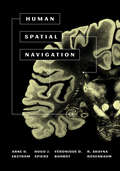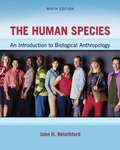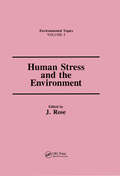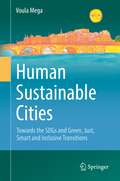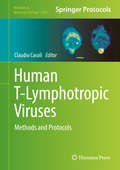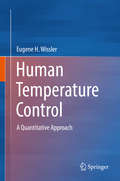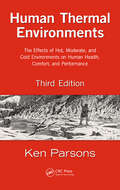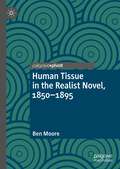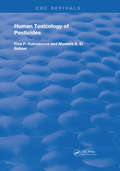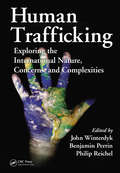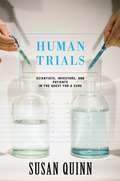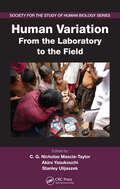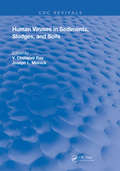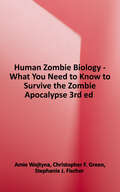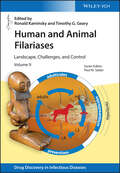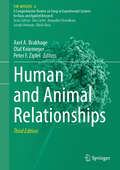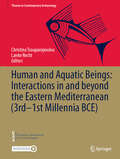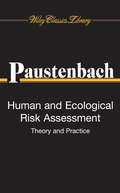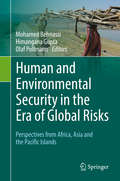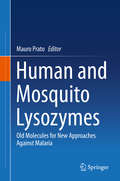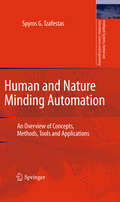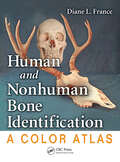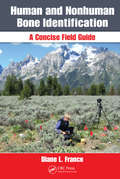- Table View
- List View
Human Space Exploration (World Book's Solar System and Space Exploration Library)
by Karen Ingebretsen"Introduction to space exploration, providing to primary and intermediate grade students information on astronauts, space shuttles, and space stations. Includes fun facts, glossary, resource list and index."--Provided by publisher.
Human Spatial Navigation
by Arne D. Ekstrom Hugo J. Spiers Véronique D. Bohbot R. Shayna RosenbaumThe first book to comprehensively explore the cognitive foundations of human spatial navigationHumans possess a range of navigation and orientation abilities, from the ordinary to the extraordinary. All of us must move from one location to the next, following habitual routes and avoiding getting lost. While there is more to learn about how the brain underlies our ability to navigate, neuroscience and psychology have begun to converge on some important answers. In Human Spatial Navigation, four leading expertstackle fundamental and unique issues to produce the first book-length investigation into this subject. Opening with the vivid story of Puluwat sailors who navigate in the open ocean with no mechanical aids, the authors begin by dissecting the behavioral basis of human spatial navigation. They then focus on its neural basis, describing neural recordings, brain imaging experiments, and patient studies. Recent advances give unprecedented insights into what is known about the cognitive map and the neural systems that facilitate navigation. The authors discuss how aging and diseases can impede navigation, and they introduce cutting-edge network models that show how the brain can act as a highly integrated system underlying spatial navigation. Throughout, the authors touch on fascinating examples of able navigators, from the Inuit of northern Canada to London taxi drivers, and they provide a critical lens into previous navigation research, which has primarily focused on other species, such as rodents. An ideal book for students and researchers seeking an accessible introduction to this important topic, Human Spatial Navigation offers a rich look into spatial memory and the neuroscientific foundations for how we make our way in the world.
Human Species: An Introduction to Biological Anthropology Ninth Edition
by John RelethfordIn its ninth edition, The Human Species continues to provide a comprehensive approach to biological anthropology, especially the relationship between biology and culture, behavior in an evolutionary context, and humans as a species within the primate order. With its lively narrative and emphasis on the most current topics and findings in the field, The Human Species explores the major questions that concern biological anthropologists about our species.
Human Stress and the Environment
by Allen H. RoseFirst published in 1994. This volume is devoted to a study of the relationship between stress and health. The aim of this work is to present an account of this complex and difficult problem, without the sensationalism often associated with modern environmental remedies.
Human Sustainable Cities: Towards the SDGs and Green, Just, Smart and Inclusive Transitions
by Voula MegaThis book argues that accelerating action toward sustainability for and by cities and their inhabitants can make a huge difference to humanity’s endeavor to recover from current crises and build a sustainable future. It sheds light on cutting-edge concepts and actions toward sustainability that can taken by and for cities and with citizens. In this book, author Voula Mega takes the reader on a journey inside and across cities and highlights efforts toward a paradigmatic shift that reconciles human systems with nature. Leadership, education, innovation, trust and citizen empowerment all play a crucial role for the co-invention of a new model that balances human well-being, sustainable prosperity and the future of the planet. Building on robust evidence and inspired by best practices, Human Sustainable Cities offers compelling messages and convincing advice to all stakeholders who are striving to overcome crises, speed up the path toward resilience and preparedness and bounce forward better.
Human Systems Interactions: FOSS Science Resources
by Lawrence Hall of Science University of California at BerkeleyNIMAC-sourced textbook
Human T-Lymphotropic Viruses
by Claudio CasoliWhile HIV-1 continues to be well-researched, this detailed volume draws attention to other members of the Retrovirus family, namely the Human T-lymphotropic Viruses (HTLVs), featuring the most updated technical information about HTLV determination and the methods to investigate their interaction with the host immune system and interfering pathogens. The contents include essential aspects of epidemiology and virus transmission, novel and robust methodologies for studying the effects of trans-activating regulatory HTLVs' proteins, the latest techniques for genotyping and gene expression analysis, as well as cellular phenotype and dynamics. Written in the highly successful Methods in Molecular Biology series format, chapters include introductions to their respective topics, lists of the necessary materials and reagents, step-by-step, readily reproducible laboratory protocols, and tips on troubleshooting and avoiding known pitfalls. Authoritative and practical, Human T-Lymphotropic Viruses: Methods and Protocols serves as an ideal guide to an area of study that is very much worthy of further research.
Human Temperature Control: A Quantitative Approach
by Eugene H. WisslerThe principal objective of this book is to provide information needed to define human thermal behavior quantitatively. Human thermal physiology is defined using mathematical methods routinely employed by physicists and engineers, but seldom used by physiologists. Major sections of the book are devoted to blood flow, sweating, shivering, heat transfer within the body, and heat and mass transfer from skin and clothing to the environment. Simple algebraic models based on experimental data from a century of physiological investigation are developed for bodily processes. The book offers an invaluable source of information for physiologists and physical scientists interested in quantitative approaches to the fascinating field of human thermoregulation.
Human Thermal Environments: The Effects of Hot, Moderate, and Cold Environments on Human Health, Comfort, and Performance, Third Edition
by Ken ParsonsIn the ten years since the publication of the second edition of Human Thermal Environments: The Effects of Hot, Moderate, and Cold Environments on Human Health, Comfort, and Performance, Third Edition, the world has embraced electronic communications, making international collaboration almost instantaneous and global. However, there is still a need
Human Tissue in the Realist Novel, 1850-1895 (Palgrave Studies in Literature, Science and Medicine)
by Ben MooreThis Pivot engages with current debates about anthropocentrism and the Anthropocene to propose a reappraisal of the realist novel in the second half of the nineteenth century. Through three case studies, it argues for ‘human tissue’ as a conceptual tool for reading that brings together biology, literature and questions of layering. This new approach is shown to be especially salient to the Victorian period, when the application of ‘tissue’ to biology first emerges. The book is distinctive in bringing together theoretical concerns around realism and the Anthropocene – two major topics in literary criticism – and presenting a new methodology to approach this conjunction, demonstrated through original readings of Charles Kingsley, George Eliot, and Emile Zola and two English-language writers he influenced (George Moore and Vernon Lee).
Human Toxicology of Pesticides (Routledge Revivals)
by Fina P. Kaloyanova M. A. El BatawiFirst Published in 1991, this book conducts a systematic analysis of existing information regarding the toxicological effects of pesticides on humans. The book identifies the negative health effects related to exposure to pesticides and the biological changes required to undertake biological monitoring. The book also discusses the importance and magnitude of the problem for different kinds of pesticide applications in different parts of the world, explains the toxicodynamics and clinical picture of acute and chronic intoxications resulting from exposure to different groups of pesticides and selected individual substances, and evaluates existing methods and limitations for assessing human exposure to pesticides. Pesticide manufacturers, occupational health professionals, epidemiologists, environmentalists, government agencies and others concerned with the effects of pesticides on human populations should consider this book essential reading.
Human Trafficking: Exploring the International Nature, Concerns, and Complexities
by Benjamin Perrin John Winterdyk Philip ReichelHuman trafficking is a crime that undermines fundamental human rights and a broader sense of global order. It is an atrocity that transcends borders with some regions known as exporters of trafficking victims and others recognized as destination countries. Edited by three global experts and composed of the work of an esteemed panel of contributors,
Human Trials: Scientists, Investors, And Patients In The Quest For A Cure
by Susan QuinnSusan Quinn's extraordinary story takes the reader into the closed world of experimental "human trials" in which new drugs are developed. Both the portrait of a dedicated scientist and the archetypal story of all medical research, Human Trials is the emotion-laden, roller-coaster trip from the lab bench to the medicine cabinet, in which scientists risk their reputations, venture capitalists their millions, and patients their very lives. A Merloyd Lawrence Book
Human Variation: From the Laboratory to the Field (Society for the Study of Human Biology)
by Stanley Ulijaszek C. G. Nicholas Mascie-Taylor Akira YasukouchiThe transition in anthropological and biomedical research methods over the past 50 years, from anthropometric and craniometric measurements to large-scale microarray genetic studies has resulted in continued revision of opinions and ideas relating to the factors and forces that drive human variation. Human Variation:From the Laboratory to the Field
Human Viruses In Sediments Sludges & Soils (Routledge Revivals)
by V. Chalapati Rao Joseph L. MelnickFirst published in 1991, this book conducts a systematic analysis of information regarding the viral effects of sediments, sludges, and soils on humans. Industrial manufacturers, health professionals, governmental agencies and others concerned with the effects of chemical waste on human populations should consider this book essential reading.
Human Zombie Biology: What You Need to Know to Survive the Zombie Apocalypse, Third Edition
by Amie Wojtyna Christopher F. Green Stephanie J. FischerZombies aren’t real. To our knowledge, there are no secret government laboratories working on creating or defeating the zombie menace, but if such laboratories are ever created, then sign us up to be the earth’s last, best hope. Human Zombie Biology provides students the knowledge to gain a greater understanding of the concepts of biology as they apply to zombies. The Centers for Disease Control and Prevention (CDC) has even used zombies to educate the American Public on how to be prepared for any emergency, using the philosophy that if you are prepared for the zombies, you are certainly prepared for whatever Mother Nature may throw at you. It is in this spirit that we offer you this book; what better way to learn the concepts of Biology than by using our friend the zombie? Think you don’t use biology? Think again. Every time you take a deep sniff of air to determine if there is a decaying zombie nearby-- or, slightly more likely, to determine if the old take-out food in the back of your fridge is safe to eat it―then you are using biology. Since people have started talking and then writing about zombies these stories have been a reflection of society, and have drawn upon scientific knowledge to make the stores as realistic as possible. So realistic are these stories that they make for excellent educational tools as they both grab your attention and can impart knowledge. Included with your eBook purchase, you will also receive access to KHQ, Kendall Hunt’s exclusive custom study app. Designed for today’s fast-paced environment, KHQ features chapter quizzes and flashcards that empower students to learn on the go!
Human and Animal Filariases: Landscape, Challenges, and Control (Drug Discovery in Infectious Diseases)
by Paul M. SelzerHuman and Animal Filariases The rational approach to controlling human and animal diseases caused by nematodes Filariae are a family of parasitic worms which infect animals and humans, causing severe diseases such as elephantiasis (lymphatic filariasis) and river blindness (onchocerciasis) in humans, as well as heartworm disease (dirofilariasis) in dogs and cats. While the human diseases are rarely fatal, the blindness and disfiguration resulting from these infections constitute a severe burden for the affected individuals and to the healthcare systems in many tropical countries. In 2017, the World Health Organization classified several filariases as neglected tropical diseases and announced a new program seeking to eradicate these infections, which has in turn sparked a new push to develop antifilarial drugs. Considering the current and future import of this topic, Human and Animal Filariases takes a comprehensive look at infections by filarial parasites in humans and in animals. It begins by reviewing the current state of diagnosis and chemotherapy, before addressing the increasing resistance to available antifilarial drugs. This is followed by strategies and approaches for the discovery of novel drugs and finally by looking at alternative and supplementary approaches to combat the parasites, including vector control and vaccination. Human and Animal Filariases readers will find: A comprehensive approach that integrates current chemotherapy with recent advances in antifilarial drug discovery Practical information on assay development, target validation, and required drug product profiles Insights from global experts from leading academic institutions as well as from pharma and healthcare companies Human and Animal Filariases is a unique reference for parasitologists, veterinarians, as well as professionals in the pharmaceutical industry and in public health agencies.
Human and Animal Relationships (The Mycota #6)
by Axel A. Brakhage Peter F. Zipfel Olaf KniemeyerEstimates based on sequencing data suggest that there are around 5.1 million species of fungi. Yet only a small number of fungi are harmful to animals, including humans. In addition to host-pathogen interactions, there are also mutualistic interactions between fungi and animals. Diseases caused by pathogenic fungi range from allergic reactions and superficial infections to invasive mycoses, and have a significant impact on human and animal life. Fungi are also cultivated by animals as a food source in highly developed relationships or are even involved in gut mutualism. This 3rd edition of Volume 6 of The Mycota highlights exemplary interactions between fungal pathogens and their host(s). The book is organized in three parts: Part 1 summarizes our current understanding of important pathogenic fungi such as Candida species, Malassezia yeasts, Aspergillus fumigatus and fungi of the order Mucorales. Part 2 addresses the characterization of the host response towards pathogenic fungi. It focuses on RNA as a mediator of host-pathogen interactions, the human gut mycobiome, the role of the innate immune system in fighting infections, pattern recognition receptors involved in fungal infections, and a summary of established infection models for studying host-fungal-pathogen interactions. Part 3 provides insights into the impact transcriptomics and proteomics technologies have on the research of human-pathogenic fungi. The up-to-date reviews by experts in the field provide the reader with a comprehensive overview of the various research topics in the field of human and animal relationships with fungi and will hopefully help researchers to find inspiration for their own research.
Human and Aquatic Beings: Interactions in and beyond the Eastern Mediterranean (Themes in Contemporary Archaeology)
by Lærke Recht Christina TsouparopoulouThis volume examines the role of fish and molluscs in everyday life as well as in terms of their impact on social structures, and as part of ideological and symbolic expression. Given the prevalence of anddependence on water in various forms in all regions of the Eastern Mediterranean, Egypt and Western Asia, it is no wonder that fish and other aquatic species made an impact on human lives. Yet this topic remains rather understudied. Until recently, ongoing projects in marine and freshwater species and their interaction with humans and the environment either focus on the European marine ecosystem or on themes other than the social interactions of humans and aquatic species. The chapters in this volume explore questions related to fishing practices and technologies, social status, human-fish/mollusc relations (including potential over-exploitation), and fish/molluscs in ritual practices (e.g. as temple offerings, festival consumption, burial offerings), and ideology and religion (e.g. associated with supernatural beings or sacred space, as hybrid creatures, and as represented in luxury goods). The volume also examines aquatic species as a nonalimentary resource, for example as jewellery, inlays, dyeing and medicinal purposes. The material under investigation includes faunal remains (worked and unworked), fishing gear and related tools, iconography and written sources. Many chapters also integrate multiple lines of evidence, ranging from stylistic, contextual and iconographic analyses to zooarchaeological investigations. This volume is relevant to archaeologists, zooarchaeologists, biologists and anyone interested in human-animal relations and/or the archaeology of the early Eastern Mediterranean and surrounding regions.
Human and Ecological Risk Assessment: Theory and Practice (Wiley Classics Library)
by Dennis J. PaustenbachHuman and Ecological Risk Assessment: Theory and Practice assembles the expertise of more than fifty authorities from fifteen different fields, forming a comprehensive reference and textbook on risk assessment. Containing two dozen case studies of environmental or human health risk assessments, the text not only presents the theoretical underpinnings of the discipline, but also serves as a complete handbook and "how-to" guide for individuals conducting or interpreting risk assessments. In addition, more than 4,000 published papers and books in the field are cited. Editor Dennis Paustenbach has assembled chapters that present the most current methods for conducting hazard identification, dose-response and exposure assessment, and risk characterization components for risk assessments of any chemical hazard to humans or wildlife (fish, birds, and terrestrials). Topics addressed include hazards posed by: Air emissions Radiological hazards Contaminated soil and foods Agricultural hazards Occupational hazards Consumer products and water Hazardous waste sites Contaminated air and water The bringing together of so many of the world's authorities on these topics, plus the comprehensive nature of the text, promises to make Human and Ecological Risk Assessment the text against which others will be measured in the coming years.
Human and Environmental Security in the Era of Global Risks: Perspectives from Africa, Asia and the Pacific Islands
by Mohamed Behnassi Olaf Pollmann Himangana GuptaThis book discusses ways to deepen the debate on the linkages between global risks and human and environmental security. The approach put forward in this book is one of questioning the ability of existing concepts, regulatory frameworks, technologies and decision-making mechanisms to accurately deal with emerging risks to human and environmental security, and to act in the direction of effectively managing their impacts and fostering the resilience of concerned systems and resources. Empirical research findings from Africa, Asia and the Pacific Islands are provided.During the last decades the links between emerging risks and the security of humans and nature have been the object of considerable research and deliberations. However, it is only recently becoming an important focus of policy making and advocacy. In this contributed volume, it is presumed that the ability – or lack thereof – to make innovative conceptual frameworks, institutional and policy arrangements, and technological advances for managing the current emerging risks, will foster or undermine the environmental security, and consequently determine the future human security. Moreover, taking into account the links between environmental/climate security, human security and sustainability will help frame a new research agenda and potentially develop a broad range of responses to many delicate questions.
Human and Mosquito Lysozymes
by Mauro PratoMalaria remains an alarming emergency in developing countries. It is thus urgent to identify any parasite or host molecules that can serve as new affordable markers for early diagnosis of disease complications or as new targets for vector control. In this context, human and mosquito lysozymes are good candidate molecules, as their involvement in malaria has been recently reported by several independent groups. This book reviews the grounded knowledge on malaria etiology and physiopathology, as well as the current approaches for diagnosis, therapy, and vector control. In addition, the emerging evidence on the involvement of human and mosquito lysozymes in malaria from available experimental models and clinical studies is thoroughly discussed, as is the potential use of other antimicrobial peptides against malaria. Intriguingly, the contributors propose that old well-known molecules such as lysozymes might be used as new targets for cost-effective strategies to fight malaria.
Human and Nature Minding Automation
by Spyros G. TzafestasThis book examines the "symbiosis" of automation and technology with the human and the nature towards the ultimate goal of assuring global sustainability. Throughout the years a variety of approaches, technologies and practices have been produced in the direction of achieving human-and nature-minding automation and industrial activity. In this book an attempt is made, for the first time, to present in a cohesive and consolidated way an overview of all these issues together, and show how they combine to provide human-and nature-minding (green) systems. Human-minding automation is possible by employing concepts and techniques from the human factors and ergonomics fields, including job satisfaction, human-friendly interfaces, and human values, whereas nature-minding industrial activity and human development can be achieved by considering as a whole the human, economic, natural and cultural resources in the short and long term. In particular, nature-minding design selects the production methods and technologies that have the minimum impact to the nature. The book is intended for use both as a free reference conceptual book, and as general introductory book in relevant teaching and research environments.
Human and Nonhuman Bone Identification: A Color Atlas
by Diane L. FranceWhen a bone of unknown origin is found at a location, forensic implications arise immediately. Is this bone human, and if so, is it evidence of a murder? Human and Non-Human Bone Identification: A Color Atlas presents a comprehensive handbook of photographs and other information essential for law enforcement and forensic anthropologists when examin
Human and Nonhuman Bone Identification: A Concise Field Guide
by Diane L. FranceIn Human and Nonhuman Bone Identification: A Color Atlas,Diane L. France, one of the most respected forensic anthropologists in the world, offered a comprehensive handbook of photographs and other information essential for examining skeletal remains and determining species and body parts.Conveniently designed for field use, this compact version of

